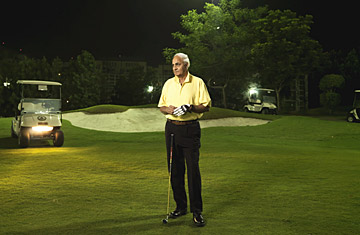
TOP OF THE WORLD: DLF chairman K.P. Singh says the windfall from his company's IPO "is embarrassing to me. That is not the yardstick by which I want to be known."
From the window of his ninth-floor office, Kushal Pal Singh looks down over New Delhi's Jantar Mantar, an elaborate astronomical observatory built by a far-sighted 18th century Hindu ruler renowned for his diplomacy and the monuments he left behind. The stone curves and pillars of the observatory worked in conjunction with its massive sundial to create one of the most reliable and accurate scientific instruments of the day, allowing astronomers to measure time, forecast eclipses and determine the positions of stars and planets. The Jantar Mantar "gave me inspiration," says Singh, the chairman of DLF, India's largest real estate company. "And the inspiration was that if this guy who conceived and made the Jantar Mantar centuries ago could be a forward-looking man, why is it that we can't be forward looking in our development and start to do something ahead of the time?"
If you listen to Singh tell it, DLF is doing just that. Barely known outside its north Indian base a few years ago, the company is building houses, apartments, office towers and shopping malls across India. It has plans for airports, hotels and cinemas. Singh, 75, doesn't just want to cash in on India's economic boom, he wants to be a prime mover in the country's drive to erect modern cities where India's new middle class can live, work, shop and play. To do all that, though, DLF needs a lot more money, which is why on July 5 the company listed on the Bombay and National stock exchanges. An initial public offering for just over 10% of the company closed in mid-June and brought in some $2.24 billion. In the three weeks after it listed, DLF's shares rose nearly 9%, giving it a market capitalization of $24.5 billion — roughly $3 billion more than General Motors. The IPO, which was about twice the size of India's previous biggest, netted Singh and several family members, who together hold 87% of DLF, nearly $20 billion — enough to make them one of the richest clans in the world. "Frankly that is embarrassing to me," Singh says. "That is not the yardstick by which I want to be known. I feel proud that what I championed 25 years back has blossomed into something good for the country. That is what I want to be known for."
Whether he likes it or not, the fortune Singh has amassed is bound to attract attention. DLF is, after all, the hottest property developer in one of the hottest markets in the world. India's economy has grown at an average annual rate of more than 8% over the past four years, bestowing prosperity upon millions of Indians and boosting demand for houses, offices, megamalls and hotels. Real estate prices have skyrocketed. A 2006 study by the Federation of Indian Chambers of Commerce and Industry and professional-services firm Ernst & Young found that total revenue from sales of commercial and residential property throughout India had grown 30% a year for the previous three years. Land prices in some areas have tripled in value since 2004, while office rents in Mumbai and New Delhi are now more expensive than those in Paris, Hong Kong or midtown Manhattan, according to a 2007 survey by real estate consultant CB Richard Ellis. Yet the boom may still have room to run. Merrill Lynch forecasts India's property industry will grow to $90 billion by 2015, up from $12 billion in 2005.
During an interview in late May, Singh, who is widely known simply by his initials, K.P., espouses a similarly optimistic view. "As prosperity comes through I see massive opportunities," he says. "You will need 100 DLFs, there will be so much work." DLF, though, has a big head start on the rest of the industry, thanks largely to Singh. The amiable septuagenarian, who this day is dressed in a white suit with a polka-dot handkerchief poking from his breast pocket, recalls how prescient strategy — and a stroke of luck — turned DLF into a property powerhouse. Founded by Singh's father-in-law, Chaudhury Raghuvendra Singh, DLF (originally Delhi Land & Finance) got started in 1946, a year before India won its freedom from Britain. A former civil servant, Raghuvendra bet that hundreds of thousands of refugees, who were expected to settle in India's capital when partition split Hindu and Muslim India, would need places to live. He convinced farmers around New Delhi to hand over their land on the promise of future payment, borrowed money to develop residential neighborhoods and then sold at considerable profit to the influx of newcomers.
But the good times ended in 1957 when New Delhi's socialist government granted itself sole development rights for the city, forcing private firms out of the business. By then, K.P. Singh had married into the family and would soon join his father-in-law's firm. The son of landlords himself, K.P. had studied science and then moved to Britain to train in aeronautical engineering before returning home as an officer in the Indian army. Military life was tough and family legend has it that Singh planned to return to his engineering studies in London when he was dragged before a colonel who had learned of his intentions. "You can leave," the senior officer told him, "but you will always be known as the coward who ran away." Singh stayed, serving in the Deccan Horse, a celebrated cavalry regiment, in the early 1950s, and learned the discipline that he says would help him in business years later.